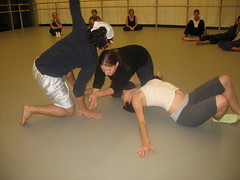
Warm up exercise: Go for a ten minute walk with one other person in the class. Do not plan a destination. Do not talk. Take notice of the sights, sounds, and people around you, and the non-verbal dynamics between you and your walking partner.
Rehash of first three weeks:Avant Garde activities of the late 1950s and 1960s (specifically Happenings and Fluxus Actions): the interest in a more democratic approach to art-making, blurring the boundaries between artists and audiences, integrating the professional with the amateur, using everyday activities and objects as the subject of new works, blending artistic disciplines. Likely a reaction to the conservatism, separatism, and social homogeneity of the 1950s.
Assignments so far: Group Fluxus Scores (impromptu physical collaboration)
Writing of Manifestos (defining ourselves within the group)
Creation of a Gift Economy (relational activity)
Recurring theme in collective works:Interest in
Utopia--a perfect place, especially in its social, political, and moral aspects. The evils of society, eg: poverty, hunger, war, are not present. Utopian beliefs in art: power of art to transform both the individual and society at large for the better. R. Buckminster Fuller was influential among 1970s avant-garde artists because he proposed that we now have the technology to eliminate human suffering through cooperation.
Social Sculpture/Social ArchitectureJoseph Beuys' term for how we mould and shape the world we live in through conscious artistic action.
Group reading of "I Am Searching for Field Character" (1973) written by Joseph Beuys and included in Claire Bishop's
Participation: Documents of Contemporary Art.
Works by Beuys:Documenta 5: Bureau for Direct Democracy: an installation where Beuys debated political, art and social issues with gallery visitors for 100 days. On the last day, he fought a Boxing Match for Direct Democracy with one of his students.
7000 Oaks: Begun in 1982 at Documenta 7, Beuys planned for 7000 trees to be planted throughout the greater city of Kassel, completed in 1987. Beuys intended the Kassel project to be the first stage in an ongoing scheme of tree planting to be extended throughout the world as part of a global mission to effect environmental and social change; locally, the action was a gesture towards urban renewal (from Dia Foundation website).
What were Beuys' assertions?• every person is a creator/sculptor of the larger social organism
• art is a tool for molding a better society
• communication via art as a two-way flow
• staging sculpture-- sculpture is performance
• sculpture should be in motion/in process
• art has healing potential
Read Bill Arning's essay: "Sure, everyone might be an artist, but only one artist gets to be the guy who says that everyone else is an artist", from
What we want is free, edited by Ted Purves.
Assignment 4:As a group, create a temporary "use space" on campus which will take place during our class on
Wednesday, September 26, 6-8pm. Ideas: film screening, potluck, free services: massage, instructional demonstration, a series of all of the above, multiple instructions, a lending library, a barter event, a giveaway event. Title the event, make hand flyers, advertise it to the student body. Document.









































